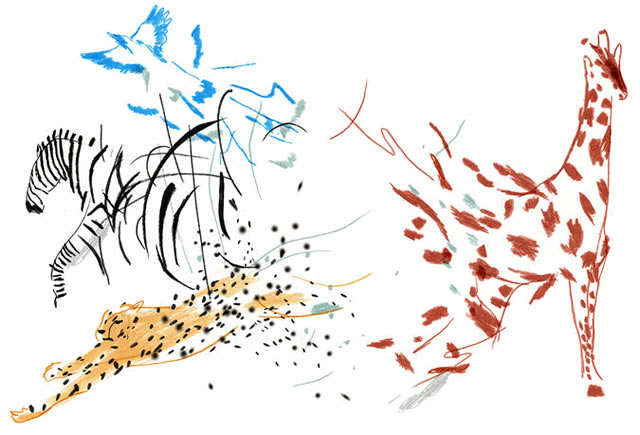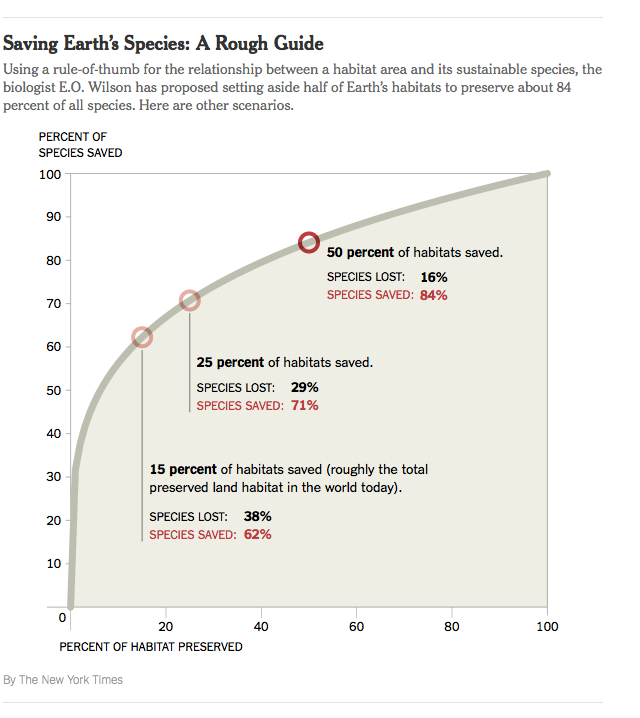In this morning’s New York Times Op-Ed, E.O. Wilson explains why we must vastly increase the area of protected natural reserves in order to conserve the immensity of life upon which we absolutely depend, and which depends upon us.
“The Global Solution to Extinction”
E.O. Wilson, Opinion, The New York Times, March 12, 2016
During the summer of 1940, I was an 11-year-old living with my family in a low-income apartment in Washington, D.C. We were within easy walking distance of the National Zoo and an adjacent strip of woodland in Rock Creek Park. I lived most of my days there, visiting exotic animals and collecting butterflies and other insects with a net that I had fashioned from a broom handle, coat hanger and cheesecloth. I read nature books, field guides and past volumes of National Geographic. I had already conceived then of a world of life awaiting me, bottomless in variety.
Seventy-six years later, I have kept that dream. As a teacher and scientist I have tried to share it. The metaphor I offer for biological diversity is the magic well: The more you draw, the more there is to draw.
But today the dream is at risk. Civilization is at last turning green, albeit only pale green. Our attention remains focused on the physical environment — on pollution, the shortage of fresh water, the shrinkage of arable land and, of course, the great, wrathful demon that threatens all our lives, human-forced climate change. But Earth’s living environment, including all its species and all the ecosystems they compose, has continued to receive relatively little attention. This is a huge strategic mistake. If we save the living environment of Earth, we will also save the physical, nonliving environment, because each depends on the other. But if we work to save only the physical environment, as we seem bent on doing, we will lose them both.


Illustration by Jon Han
So, what exactly is the current condition of the living environment, in particular its biological diversity and stability? How are we handling this critical element of Earth’s sustainability?
To begin, how many species of organisms are known on the planet? Here, our knowledge is pathetically weak. At the present time, about two million species have been discovered, described and given a Latinized scientific name. But how many are there actually, known and unknown? Putting aside the bacteria and a distinctive group of microbes called the archaea (which I like to call together the dark matter of biology because so little is understood of their diversity), the best estimate we have of all the rest (the fungi, algae, plants and animals) is roughly 10 million, give or take a million.
Except for the vertebrates (consisting of 63,000 described species of birds, mammals, reptiles, amphibians and fishes) and the flowering plants (with approximately 270,000 species), relatively little is collectively known about millions of kinds of fungi, algae and most diverse of all, the insects and other invertebrate animals. And that matters, a lot: These least understood minions are the foundation of the living world. They are the little things that run the Earth.
In short, we live on a little-known planet. E.T. and other alien biologists visiting Earth would, I suspect, be appalled at our weak knowledge of our homeland. They would be mystified by the scant attention humanity gives to the life-forms on which our existence depends.
The one major reserve in the United States that has been subjected to a complete census is the Great Smoky Mountains National Park. Fifty thousand hours of field work there by specialists and assistants have yielded records of 18,000 species of animals and microorganisms alone, with 40,000 to 60,000 considered likely on the roster when all transients, as well as rare and undescribed species, have been registered.


The mapping of Earth’s biodiversity was not, as many assume, mostly completed in the 19th and 20th centuries. It has only begun. The study of biological diversity is absurdly slow. Today, only about 18,000 new species are being discovered and described each year. If we continue at this rate (I’ve described only about 450 new ant species in my own lifetime), the task of mapping life on Earth, or what is left of it, will not be completed until the 23rd century.
That brings me to the extinction rate of species around the world. With data on the best known vertebrate species, and a lot of additional information from fossil studies and genetics, we can put the fraction of species disappearing each year at upward of a 1,000 times the rate that existed before the coming of humans.
Most of this loss is occurring in tropical countries, and especially tropical forests on islands. But to bring it home to the United States, consider that from 1895 to 2006, 57 species and distinct geographic races of freshwater fishes were driven to extinction, which is 10 percent of the total previously alive; hence the rate of extinction was just under 900 times that which existed before the coming of humans.
The global conservation movement, pioneered by the United States, has raised awareness of nature’s plight, and stimulated a great deal of excellent research. It has slowed the hemorrhaging of species, but is still a long way from stopping it. Conservation efforts are concentrated on the roughly one-fifth of vertebrate species worldwide that are ranked as endangered to some degree. We have managed to stabilize or reverse the decline of one-fifth of the species in this group. A better record has been achieved within the United States by the Endangered Species Act of 1973, which has brought 10 times more species back to health than have been lost in the same time period to extinction.
All this is progress, but the prospects for the rest of the century remain grim. The global conservation movement is like a surgeon in an emergency room treating an accident victim: He has slowed the bleeding by half. Congratulations, we might say — even though the patient will be dead by morning.
Unless we wish to pauperize the natural world drastically and permanently, believing that later generations will be smart enough to find a way to bring equilibrium to the land, seas and air, then we, the current inheritors of this beautiful world, must take more serious action to preserve the rest of life.
There is only one rational way to accomplish this goal, and that is to bring the extinction rate back to the level that existed before the worldwide expansion of human populations. The disappearance of natural habitat is the primary cause of biological diversity loss at every level — ecosystems, species and genes, all of them. Only by the preservation of much more natural habitat than previously envisioned can extinction be brought close to a sustainable level.
The only way to save upward of 90 percent of the rest of life is to vastly increase the area of refuges, from their current 15 percent of the land and 3 percent of the sea to half of the land and half of the sea. That amount, as I and others have shown, can be put together from large and small fragments around the world to remain relatively natural, without removing people living there or changing property rights. This method has been tested on a much smaller scale at the national and state park levels within the United States.
This step toward sustained coexistence with the rest of life is partly a practical challenge and partly a moral decision. It can be done, and to great and universal benefit, if we wish it so.
I have to think that the dream of a boy from so long ago has a chance to endure.
Edward O. Wilson, a professor emeritus at Harvard University, is the author of “Half- Earth: Our Planet’s Fight for Life.”

